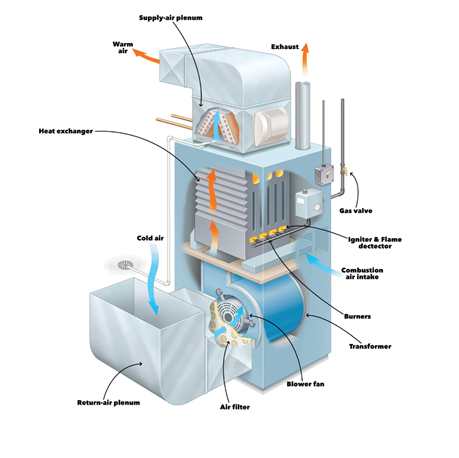Safety + comfort = peace of mind.
Furnace systems play an important role in your home, but most people don’t really know how they work or the components that make the system heat your home. By knowing more about furnace systems and how they work, you can identify problems early on so that our HVAC technicians at Ascend HVAC can repair your furnace.
How Does My Furnace System Work?
A furnace system pulls cool air from inside your home into its system. From there, your furnace system heats the air and redistributes it throughout your home through ducts and vents. There are a few types of furnaces and they can be powered by natural gas, oil, electricity, wood, propane, or coal. Most furnace systems today use natural gas, oil, or electricity.

Parts of the Furnace System
There are many parts of a furnace system that all play a role in heating the air in your home. Understanding what each of these parts does is a great way to stay ahead of furnace repairs.
- Return Register
- The return register pulls cold air from inside your home and sends it to your furnace system to be heated.
- Return Duct
- These ducts direct the cool air from the return register into the furnace to be heated.
- Air Filter
- HVAC air filters are essential in keeping the air in your home safe and healthy to breathe. The cold air passes through the HVAC air filter to trap any indoor air contaminants, pollution, or allergens. Air filters stop these contaminants from continuously redistributing throughout your home.
- Blower
- The blower is a large fan in the furnace system that blows air through the HVAC system and into the supply ductwork. The blower helps the cool air travel through the return ductwork to the furnace.
- Blower Motor
- The blower motor powers the blower and spins the fan.
- Blower Chamber
- The blower chamber is where the blower and blower motor are located. The chamber stabilizes the blower and ensures that these parts are working properly.
- Burners
- The burners create the fire in the furnace system, allowing the HVAC system to heat the air.
- Flame Sensor
- The flame sensor detects when there is a lit fire in the burner chamber. This part is integral to the safety of the furnace system. If the flame sensor doesn’t sense any heat being generated by the system, it will shut the entire system down to avoid any gas leaks or other issues.
- Pilot Light or Electronic Ignition
- Older furnaces will most likely have a pilot light as part of the system. Pilot lights will consistently run even if the furnace is off, meaning they are always using gas to stay lit.
- An electronic ignition is the updated version of the pilot light and is in most newer furnace systems. The electronic ignition will send a spark to the burner in your furnace when your home is ready for heat.
- Burner Cover
- The burner cover is a small part of the furnace system and covers the burners, flame sensor, blower chamber, and pilot light or electronic ignition. This part of the furnace keeps the flames safely inside the furnace system.
- Combustion Chamber
- The combustion chamber holds the entire fire system in place and is safely separated from the blower chamber.
- Heat Exchanger
- Heat exchangers are the part of your furnace system that provides warm air to your home. This component heats the cool air and sends combustion gases into the flue or side wall vent to be released outside of your home.
- Supply Plenum
- The supply plenum takes the newly warmed air and prepares to send it throughout your home.
- Damper
- The damper regulates how much of the newly warmed air is released into your home. It also sends the warm air to different rooms in your home, depending on which areas need it.
- Supply Duct
- The sorted air from the damper is then sent to the supply ducts to supply your home with warm air.
- Supply Register
- The last thing your furnace system does during the heating process is to pass the heated air through the supply registers into your home.
Furnace Maintenance with Ascend HVAC
To keep your furnace system running smoothly and safely, consider routine furnace maintenance from our HVAC technicians. Keep your family safe from fires, gas leaks, or other issues that may arise from your furnace system. Call Ascend HVAC today in Salt Lake City, Utah for your heating and cooling needs!